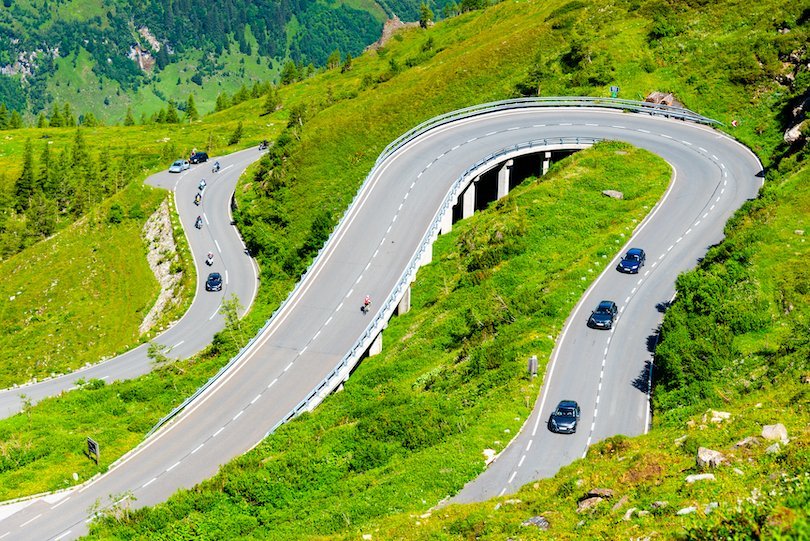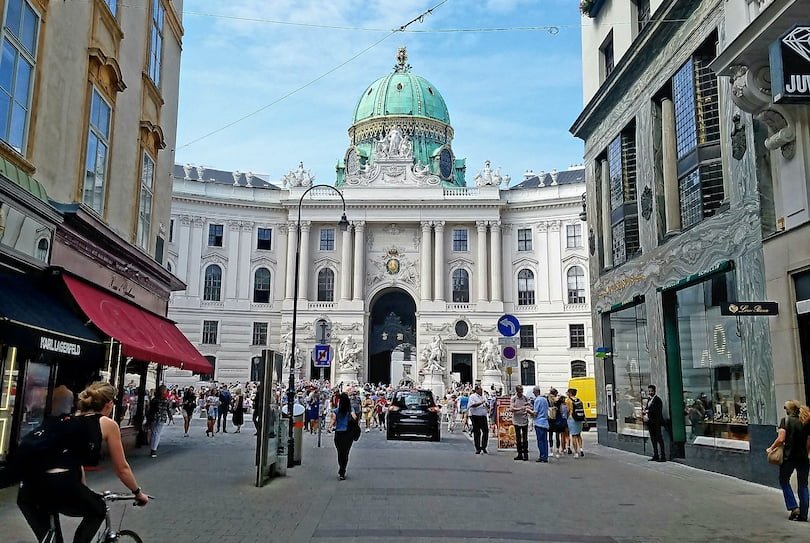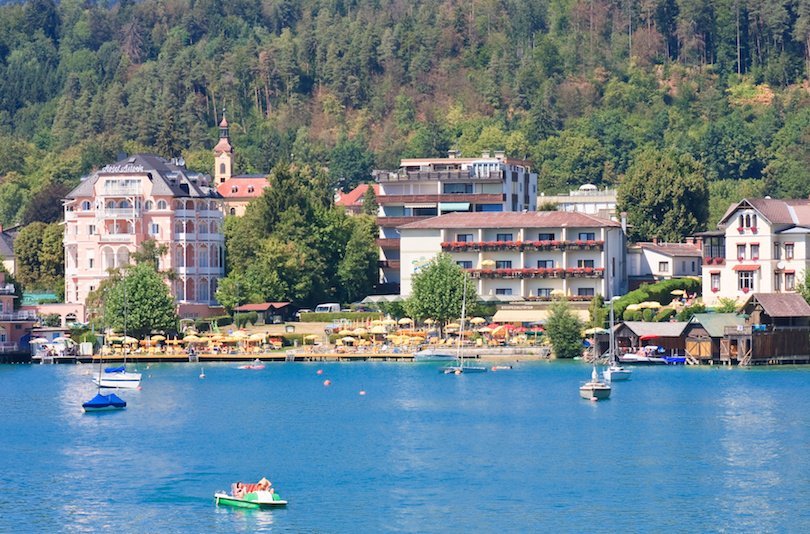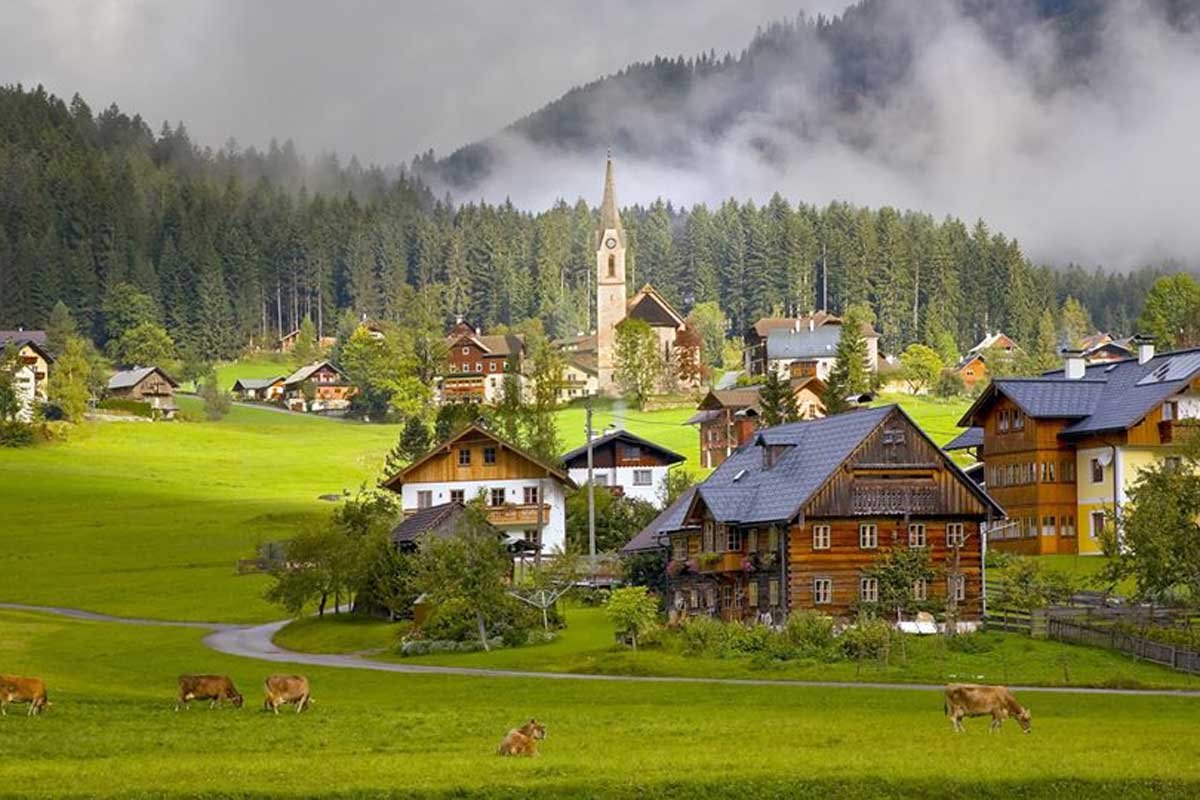12 Best Places to Visit in Austria, once a prominent part of a vast European empire, continues to reflect the grandeur of its historical achievements. Vienna, renowned for its classical music, architecture, and art, has always been a shining example of cultural brilliance. Additionally, Salzburg, the birthplace of Mozart, boasts a plethora of magnificent structures. However, Austria’s appeal extends far beyond its rich history and captivating architecture.
Situated predominantly in the Alps, Austria has become a favored destination for skiers and hikers, offering breathtaking landscapes to explore. Hidden within the lush green hillsides, charming towns await, crowned by rugged peaks. The pristine mountain air and the allure of alpine resorts are irresistible. Austria serves as a testament to the awe-inspiring beauty of mountainous scenery, valleys, and lakes. To plan your journey to this stunning Alpine country, consult our curated list of the finest places to visit in Austria.
Zillertal Alps [SEE MAP]
The Zillertal Alps, situated on the border of Austria and Italy, boasts an impressive landscape of towering glacial peaks, jagged mountain cliffs, and tree-lined valleys. With over 85 glaciers, some of which reach heights of over 11,000-feet above sea level, the Hintertux Glacier stands tall as one of the tallest and is open 365 days a year for skiing and hiking. It is one of only two ski resorts in the world that remain open year-round due to its altitude.
The Zillertal Alps is a popular destination for outdoor enthusiasts, offering hundreds of miles of trails for mountaineers, hikers, and backpackers. From beginner hikers trekking along the lower-level pastures to more advanced hikers opting for a long-distance hike through the High Alps Nature Park, there is something for everyone. For those who prefer to enjoy the landscape from the comfort of their car, the 30-mile Zillertal High Road is an alternative option.
Grossglockner Alpine Road

Considered as the most picturesque road trip in Austria, the epic 30-mile journey along Grossglockner Road is truly remarkable. Commencing in Bruck, the road leads towards the magnificent Grossglockner, towering at an impressive height of 12,461 feet, making it Austria’s tallest mountain. Along the way, the road winds through Hochtor Pass and traverses the Alpine divide, reaching a staggering elevation of 8,200 feet above sea level. This route offers awe-inspiring views of the dramatic valleys and majestic mountains that adorn the landscape.
Grossglockner Road provides an exhilarating experience for both drivers and passengers, with its abundance of hairpin turns. However, it is not only a haven for road enthusiasts but also a sought-after destination for hikers. The mountain is adorned with numerous trails and paths, attracting hikers from all around.
Among the most renowned hiking routes is the Kaiser-Franz-Josefs-Höhe lookout point, which offers panoramic vistas of Grossglockner. For a breathtaking experience, one can venture along the Gamsgrubenweg path and marvel at the stunning views. Alternatively, hikers can embark on the Pasterze Glacier path, leading to the icy glaciers, or even embark on a long-distance expedition to Slovenia and Italy through the Alpe Adria Trail.
St Anton am Arlberg

Nestled in the heart of the Tyrolean Alps lies St Anton am Arlberg, a renowned ski resort town in Austria that attracts a multitude of outdoor enthusiasts. With its vast ski area catering to various skill levels, it is a dream destination for those seeking adventure.
One of the highlights of St Anton is the majestic Valluga Mountain, standing tall at 9,215 feet. Whether you are a skier or not, you can enjoy breathtaking views of the awe-inspiring Lechtal Alps by taking the two aerial tramways, known as the Vallugabahns, to reach the summit.
While St Anton is commonly associated with winter activities, it is also a popular choice for summer getaways. As the snow melts, the town transforms into a haven for hikers, cyclists, and mountain bikers, with its verdant meadows and tree-lined forests offering idyllic trails to explore.
Beyond its natural beauty, St Anton exudes its own charm with its snow-covered mountains enveloping the town. Despite its compact size, the village boasts a plethora of traditional restaurants and cozy cafes, providing visitors with a delightful culinary experience.
Wachau
Austria’s Wachau Valley, situated in the northeastern part of the country, is a stunning 18-mile stretch characterized by breathtaking cliffs, rolling hills, and picturesque vineyards. Located along the Danube River, this valley holds great significance as one of Austria’s smallest yet most important wine regions. Numerous vineyards can be found along the river, many of which cultivate the renowned Grüner Veltliner and Riesling grapes.
Among the towns in the valley, Dürnstein stands out as a popular destination. It is home to the historic Dürnstein Castle, where Duke Leopold V once held Richard I of England captive during the Third Crusade in 1193.
To fully experience the beauty of the Wachau Valley, cycling is highly recommended. Both sides of the river offer well-maintained bike paths, allowing for an enjoyable exploration. In addition to visiting Dürnstein, it is also worth taking the time to stop by the charming towns of Melk, famous for its exquisite Benedictine abbey, Krems, Willendorf, and Spritz.
Zell am See
 © Oleksandr Osipov / Dreamstime
© Oleksandr Osipov / Dreamstime
Nestled in a picturesque valley surrounded by the majestic Kitzbuhel Alps, Zell am See is a charming alpine city that boasts stunning views. The city is situated on the shores of a crystal-clear blue lake, which gives it its name, and is adorned with cozy chalets and flower-filled meadows that cover the slopes.
During the summer months, hiking, cycling, and water sports are popular activities, while in winter, skiers and snowboarders flock to the town to take advantage of the nearby ski resorts and magnificent mountains. Despite its small size, Zell am See’s quaint center is worth exploring at any time of year for its charming alpine ambiance. One of its most famous landmarks is the Romanesque St. Hippolyte’s Church, which features an elevated walkway dating back to the early 16th century.
Thanks to its breathtaking location, Zell am See is a popular tourist destination and an important transportation hub for the Salzburg region. The towering Mount Grossglockner, Austria’s highest mountain, is located nearby, and many visitors drive along the stunning High Alpine Road that runs below it from the town.
Innsbruck

Innsbruck is situated in a stunning location, surrounded by towering mountains and situated on the banks of the Inn River. While many visitors come for the breathtaking scenery, the city itself boasts a fascinating mix of history, culture, and architecture. In the past, Innsbruck was a significant center of European politics and culture, and this is reflected in the beautiful buildings that can be found throughout the medieval old town.
Visitors can explore the Baroque Saint Jacob Cathedral, Renaissance-style Hapsburg Imperial Palace, and 16th century Schloss Ambras. In addition to its rich history, Innsbruck is also a popular destination for outdoor enthusiasts. The city offers numerous hiking trails and skiing opportunities, and visitors can take the Nordkettenbahnen cable car to the top of Nordkette mountain for stunning views of the surrounding scenery.
Salzkammergut
Salzkammergut, extending from Salzburg to the majestic Dachstein Mountains, is undeniably one of Austria’s most exquisite regions. Within its boundaries lie shimmering lakes, undulating hills, picturesque valleys, and awe-inspiring mountain ranges. Those familiar with the film “The Sound Of Music” will recognize the scenic beauty of this lake region, as it served as the backdrop for the movie, filmed in and around Salzburg and the neighboring Salzkammergut area.
This captivating region, largely untouched and brimming with natural wonders, is a haven for nature enthusiasts and outdoor adventurers. Hiking and mountain biking are popular activities, allowing visitors to immerse themselves in the pristine surroundings. Additionally, holidaymakers flock to Salzkammergut to indulge in swimming, fishing, and boating on the reflective waters of Hallstatter See, Mondsee, and Wolfgangsee, all of which are nestled amidst breathtaking landscapes.
Despite its sparse population, Salzkammergut boasts a rich history dating back to Neolithic times and derives its name from the salt mines that dot the area. Amidst the wilderness, pockets of civilization can be discovered, including charming lakeside towns like St. Wolfgang and the idyllic St. Hallstatt, both of which are well worth exploring. The latter, with its enchanting setting, is often referred to as the “pearl of Austria.”
Furthermore, visitors have the opportunity to unwind and rejuvenate in the spa town of Bad Ischl, venture underground to explore the Dachstein Ice Caves in Obertrau, or experience the thrill of paragliding from the lofty heights of Krippenstein mountain.
Salzburg

Located in central Austria, close to the German border, Salzburg is renowned for being the birthplace of the famous composer Wolfgang Amadeus Mozart. Travelers flock to this city, the fourth-largest in Austria, to witness the sights that served as inspiration for his timeless music. With its medieval fortress perched atop a hill, charming Altstadt (old town), and awe-inspiring Alpine landscapes, Salzburg’s allure captivates visitors throughout the year.
Stretching alongside the banks of the Salzach River, Salzburg exudes a historic charm that seems straight out of a fairytale. For those seeking to relive scenes from the iconic 1965 film “The Sound of Music,” must-visit attractions include the 17th-century Baroque Mirabell Palace and Gardens, the gazebo in the gardens of Schloss Hellbrunn, and the actual von Trapp family home, now transformed into a hotel. Mozart enthusiasts can explore his birthplace and a meticulously reconstructed version of his home, complete with period instruments, portraits, and musical scores.
Standing 120 meters (400 feet) above the city, the Festung Hohensalzburg is a 900-year-old fortress primarily built for display rather than defense. While many of the castle’s medieval artifacts were lost during the Napoleonic Wars, the true treasures lie in the breathtaking views from the fortress. Visitors can reach the castle by foot or enjoy a swift ride in a 19th-century funicular.
Whether strolling through Altstadt, admiring the abundance of Baroque architecture, or unwinding in an open-air beer garden while savoring a local brew, Salzburg is a destination that caters to all the senses.
Vienna

Vienna, the capital of Austria and its largest city, is often associated with elegant waltzes and the renowned composer Johann Strauss. However, it is also a city that boasts a rich musical heritage, with classical composers such as Mozart, Brahms, Beethoven, and Schubert having left their mark. In addition to its musical legacy, Vienna is known for its impressive architecture, which can be explored along the Ringstrasse, a circular road that once marked the boundaries of the ancient city.
From Gothic churches to Art Nouveau exhibition centers, and from Baroque palaces to modern art museums, the city’s architectural diversity is truly captivating. Notable landmarks include the opulent Schönbrunn Palace, the Kunsthistorisches Museum, and the Belvedere Palace, where one can admire the works of Gustav Klimt, one of Vienna’s most celebrated painters.
Vienna’s cultural offerings extend beyond music and architecture. Visitors can witness the world-renowned Vienna Philharmonic’s performances at the awe-inspiring State Opera House or immerse themselves in the vibrant local DJ scene, which is pushing the boundaries of Vienna’s musical landscape. Culinary delights are also abundant in Vienna, with a wide range of gastronomic pleasures to indulge in, from savory sausages and schnitzels to delectable chocolates and cakes.
Moreover, Vienna is famous for its traditional coffee houses, which can be found in every neighborhood. Some of these establishments have been serving coffee for centuries, offering not only exceptional coffee creations but also providing havens for relaxation and contemplation amidst the city’s picturesque setting along the Danube River.
Bad Gastein

Bad Gastein, a charming spa town nestled in the heart of Austria’s High Tauern Mountains, boasts a breathtaking landscape of lush forests and steep, mountainous cliffs. Its stunning Belle Epoque architecture adds to the town’s picturesque charm. One of the most notable landmarks in the area is the Grand de l’Europe Hotel, an 11-story building perched on the mountain slopes, offering a stunning view of the city below.
The town center is also home to the impressive Bad Gasteiner Waterfall, which flows directly through the middle of the town. Visitors flock to Bad Gastein to experience the therapeutic benefits of the thermal spring waters. The area is home to dozens of resorts and thermal baths that offer radon therapy, which is believed to treat issues related to the immune, musculoskeletal, and respiratory systems.
Worthersee

The Worthersee, situated in the southern part of Austria at the base of the Gurktal Alps and Karawanks mountain range, is the largest lake in Carinthia. It is a highly sought-after tourist destination due to its stunning location and scenery. During the summer season, the warm waters of the lake attract many visitors who come to swim and enjoy the Mediterranean climate.
The lake is surrounded by verdant forests, which offer excellent opportunities for hiking. Additionally, there is a picturesque bike path that runs along the lakeside. The Worthersee is an ideal place for outdoor enthusiasts, with activities such as horseback riding, golf, and watersports.
Although it was once referred to as ‘Austria’s Monte Carlo’ because of the Viennese nobility and bourgeoisie who frequented the area, it is now a more family-friendly destination. Along the lake’s shores, you can find charming towns, relaxing spas, and lively nightlife venues.
Graz is one of the 12 Best Places to Visit in Austria
 © Marazem / Dreamstime
© Marazem / Dreamstime
Graz, the second-largest city in Austria, offers a delightful experience for visitors. Situated on the banks of the Mur River, surrounded by fertile farmland, lush forests, and rolling hills, the city’s natural beauty is captivating. Throughout its history, Graz has been a coveted location, witnessing the rule of various powers such as the Romans, Hapsburgs, Hungarians, Ottomans, and Napoleon, which adds to its historical significance.
As the capital of Styria, Graz boasts an exceptionally well-preserved historic center, making it one of the finest in all of Central Europe. The juxtaposition of Baroque palaces, Renaissance courtyards, centuries-old churches, and modern museums creates a unique blend of architectural styles. The iconic clocktower atop the tree-covered Schlossberg Hill stands as the heart of the city, offering a picturesque view.
Despite its rich historical heritage, Graz exudes a vibrant and youthful atmosphere. The city’s lively nightlife scene, filled with numerous bars, restaurants, and cafes, caters to the large student population attending the various universities and colleges scattered throughout the town.








